Most of us have heard or used the term “land-grant college” but do we really know what that means? Some people point to the Morrill Act of 1862, which established land-grant colleges, as the starting point for the Cooperative Extension Service and Agricultural Education. In this Friday Footnote we will examine the origins and mission of the 1862 land-grant colleges.
The first colleges established in America were to prepare ministers and to educate the upper classes. Examples of these early colleges are Harvard in 1638, William and Mary in 1693, Yale in 1701, and Princeton in 1746. The curriculum was classical liberal arts.
Colleges continued to proliferate through the 1700 and the 1800s. By 1860 there were close to 400 colleges in America and nearly all of them were devoted to the liberal arts. Only 3% of these colleges had Departments of Science. The study of agriculture at these colleges was a rarity.
The scientific knowledge regarding agriculture was woefully lacking in the 1800s. Fathers taught their sons how to farm in the same manner their fathers had taught them. There were some farm publications such as the American Farmer newspaper where people shared their “knowledge” but it was often inaccurate.
For example, the February 1826, issue of the American Farmer (No. 10, Vol. 8) informs us that “A sheep which is fat, has usually comparatively coarse wool; and one which is lean, either from want of food or disease, has the finest wool; and the very same sheep may, at different times, according to these circumstances, have fleeces of all the intermediate qualities from extreme fineness to comparative coarseness” (p. 73). Clearly, the farmer needed more accurate knowledge than this. There was a need for colleges where scientific agriculture could be taught.
In 1862 the Morrill Act was passed and signed into law. Basically, this law created public colleges where agriculture and mechanical arts were to be taught. The legislation gave federal lands to each state to sell to support the establishment of a college. Each state received 30,000 acres per senator and representative in Congress. If no available public lands were left in the state, land in other states (generally out west) was given to states to sell in the form of “land scrip”. The money generated from the sale of the land was to be invested and the income generated was to support the college.
Section 4 of the Morrill Act specifies the purpose of these colleges: “…to the endowment, support, and maintenance of at least one college where the leading object shall be, without excluding other scientific and classical studies and including military tactics, to teach such branches of learning as are related to agriculture and the mechanic arts…in order to promote the liberal and practical education of the industrial classes in the several pursuits and professions in life.” (bolded text mine)
Several points need be made about Section 4 of the Morrill Act:
The reason the legislation said at least one college was because some states had one college that focused on mechanical arts (engineering) and another that focused on agriculture. Thus both could share in the Morrill Act funding. The Massachusetts Agricultural College (created in 1863 – now the University of Massachusetts) and the Massachusetts Institute of Technology (founded in 1861) were both declared land-grant colleges by the state legislature. This was true in several other states
Agriculture and mechanical arts were to be the primary subjects for study. However, other scientific subjects and the liberal arts were not to be ignored.
The reason military tactics was mentioned was because of the Civil War. The southern states had seceded from the Union and were not eligible to receive Morrill funding. The Union needed trained military officers for the war effort, thus this provision.
The phrase that such branches of learning as are related created problems. At least one university (the University of North Carolina) that was designated as the land-grant college, had a long history as a liberal arts college. Thus, they interpreted the “related” phrase to mean they could teach chemistry and biology and be in compliance with the intent of the legislation because those subjects were related to agriculture. The college leaders argued that the Morrill Act did not require the actual teaching of agriculture and mechanical arts – just subjects related to those topics.
These new colleges, also known as the “People’s Colleges”, were for the industrial classes. In other words, they were for the common folks; not the elite like the existing colleges.
The following series of cartoons from Iowa State University sums up, in a humorous way, the concept of the land-grant college (Written by Diana Pounds, Illustrated by Buck Jones. Cartoon source https://www.morrill.iastate.edu/cartoon/)
 |  |
| Universities used to be for certain types of people. | In 1862, Congress passed the Morrill Act, creating a new kind of university. Iowa was first to accept the law's provisions. |
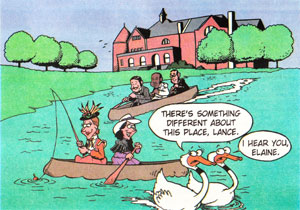 | 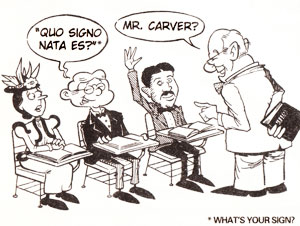 |
| The land-grants were founded on three radical ideas. | Idea No. 1: Higher education should be open to all -- women, minorities, the working class. |
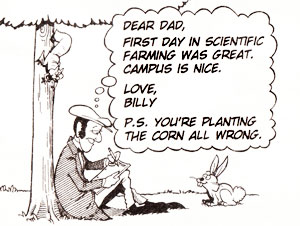 | 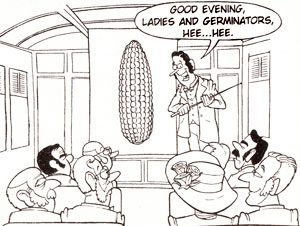 |
| Idea No. 2: Universities should teach practical subjects like farming, engineering and home ec. | Idea No. 3: Universities should share knowledge with people throughout their states. Iowa State profs started the first traveling farmer institutes and "seed corn trains." |
The Backstory
Justin Morrill, the sponsor of the land-grant bill, was a senator from Vermont. However, the “real” father of the land-grant colleges was Jonathan Baldwin Turner of Illinois. In 1851 Turner had advocated an Industrial University plan for the state of Illinois. As Turner refined his plan, he advocated federal land grants to establish such universities and had even recruited Representative Yates of Illinois to introduce legislation in the U.S. Congress to create land-grant colleges, but Yates lost his reelection bid before he could introduce the legislation.
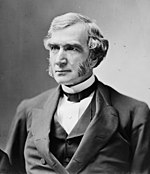
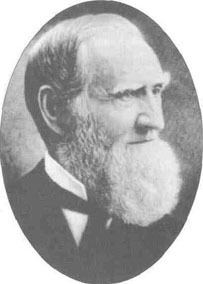
In 1856 Morrill had introduced a resolution to Congress to establish a national agricultural college (similar to the Naval Acadamy) but the resolution failed. When Turner learned of this effort, he sent all of his plans and ideas for land-grant colleges to Morrill (who never acknowledged this fact).
Morrill introduced “his” land-grant legislation to Congress in 1857, 1858 and 1859. Southerners were opposed to the bill because they believed it infringed on state rights. The bill passed both houses in 1859 but was vetoed by President Buchanan who was concerned that Southerners might secede if he signed the bill.
The two major candidates for President of the United States in 1860 were Abraham Lincoln and Stephen Douglas, both from Illinois. Turner contacted both candidates and extracted promises they would sign the Morrill Bill if elected. After the Southern states seceded from the Union, the Morrill Bill easily passed through Congress and was signed into law by President Lincoln.
But that is not really the end of the land-grant college story. The story is really just starting.
The establishment of the land-grant colleges was fraught with problems. There were debates about whether existing colleges should be designated as the land-grant college or should new institutions be established? Land prices were depressed after the Civil War, so land did not sell at the anticipated prices; thus the colleges were underfunded from the beginning.
Other major questions had to do with finding qualified faculty and administrators. Where would you go to find a university professor with both academic credentials and practical agricultural knowledge? What should the curriculum look like? What is the admission requirement for students? What would be the appropriate balance of “book learning” and “manual labor?” These were challenging questions.
These new land-grant colleges were viewed through various lenses. The established colleges and universities and the intellectuals looked down their noses at the fledgling imposters – the “cow colleges.” In reality, some of the early land-grant institutions were basically glorified high schools.
Farmers did not trust the colleges and didn’t see much value in what they were doing. These new colleges were having no impact on their farms. Groups such as the Grange were very critical and even ran some administrators off or lobbied the state legislator to revoke the land-grant status of some universities.
The Connecticut legislature removed the land-grant status from Yale in 1893 and accorded it to what is now the University of Connecticut. In 1887 the University of North Carolina at Chapel Hill relinquished their designation as a land grant college. The North Carolina legislature then created a “real” agricultural college — what is now North Carolina State University.
The mindset of some early land-grant administrators is reflected by what President Battle of the University of North Carolina (UNC) wrote after relinquishing their land-grant designation (Battle, 1912, p. 377):
What was the effect of the legislation in regard to the University? The loss of $7,500 a year was a serious matter but it had its compensations. (a) It relieved us of the charge that we were defrauding the farmers and mechanics, thereby creating much odium against us. (b) It enabled us to avoid the scandal of having a low standard of admission, which was necessary for those intending to pursue the “branches of learning relating to agriculture and mechanic arts.” Our critics used this to support the charge that we did not have a true University. (c) It enabled us to develop the institution along the lines of the most approved universities–Harvard, Yale, Columbia, Princeton, without being embarrassed by the constant demand to build stables and workshops, buy prize cattle and modern machinery. (d) It relieved us of the almost impossible task of governing in harmony bodies of students of diverse training, modes of work, aims in life.
It is obvious from what President Battle wrote that he never supported the idea of UNC being a true land-grant college for the industrial classes. On another occasion, he wrongly stated the Morrill Act REQUIRED that Latin and Greek be taught. Several other early land-grant leaders had views similar to Battle’s. No wonder the farmers were not supportive of these new colleges.
One of the major challenges faced by the early land-grant colleges was the lack of scientific knowledge in agriculture. What was the scientific basis for the courses being taught? No place in the Morrill Act is the word RESEARCH found. The Morrill Act called for the teaching of agriculture and mechanical arts but did not specifically call for research to be conducted in these areas.
To rectify the situation and establish a scientific basis for the subject matter, Congress passed the Hatch Act in 1887. This act established Agricultural Experiment Stations at the land-grant colleges. This legislation actually had two purposes. It called for “scientific investigation and experiment respecting the principles and applications of agricultural science” and it also called for “diffusing among the people of the United States useful and practical information on subjects connected with agriculture.” The provision for diffusing information was designed to show the value of land-grant colleges to the farmers. This provision of the Hatch Act eventually led to the establishment of the Cooperative Extension Service and the teaching of agriculture in the public schools.
Another problem faced by the land-grant colleges in the late 1800s was financial. There was a dire need for additional funding to support these colleges. Senator Morrill introduced legislation in 1872, 1873 and in six other years prior to 1890 seeking additional funding for land-grant colleges. Each attempt failed for a variety of reasons.
The Friday Footnote for next week will examine why the attempts to secure more funding for land-grant colleges failed and the compromise which led to the successful passage of the Second Morrill Act of 1890. Among other things, the 2nd Morrill Act created what are known as 1890 land-grant colleges. Stay tuned…next week.
Some Concluding Remarks
The purpose of this Footnote was to educate agricultural professionals about the origins and mission of land-grant colleges. These colleges have done much to advance agriculture in America. But we are also fortunate to have numerous agricultural colleges in America that are not land-grant colleges and they too have made major contributions to the improvement of agriculture.
I am a product of a non-land-grant college – Tarleton State College (now University) in Texas. My B.S. degree in agricultural education is from Tarleton and has served me well. My professors were focused on teaching. Upon graduation, I felt that I was well prepared to enter my chosen career as an agricultural educator.
We are fortunate to have the agricultural colleges in America that we do have – both the land-grant and the non-land-grants. However, I do have a concern that some land-grant colleges have forgotten their mission to serve the industrial classes. They have raised their admission requirements and tuition/fees so high that the “industrial classes” are being shut out. I have seen way too many bright, motivated young people who want to become agriculture teachers, agricultural communicators, extension agents, and others who are being denied admission. The tragedy is that we have a high demand for our graduates.
It seems that securing grant funding is the new mission for some land-grant colleges in addition to raising the academic profile of the student body so the college can rank high in the national rankings. It might be time for our college administrators to reread the Morrill Act of 1862 to rediscover what our land-grant colleges are supposed to be about.
Teaching Ideas
- Have your students select one article or letter published before 1862 from the American Farmer newspaper and have them determine if the “knowledge” or “advice” found in the article is accurate given the knowledge we have today. This might show why there was a need for agricultural colleges.
- Have your students write a research report on agricultural colleges in your state. What is the land-grant college or colleges in your state? Are there other agricultural colleges in your state other than the land-grant college(s)? What agriculture majors are available at these colleges?
Reference
Battle, K. (1912). History of the University of North Carolina. Volume II: From 1868 to 1912. Raleigh: Edwards & Broughton Printing Company.
